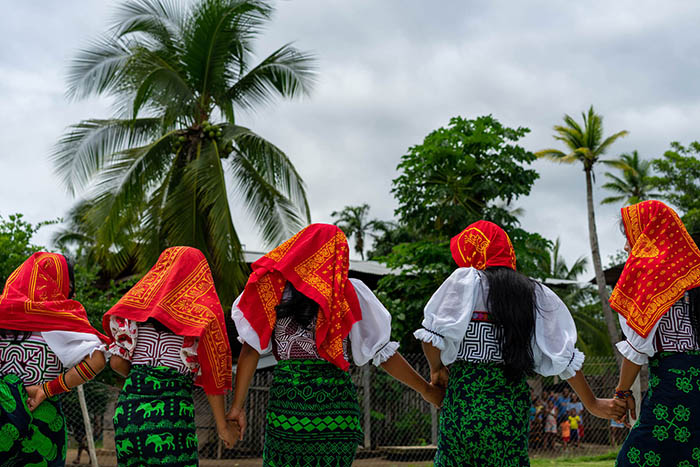Increased pressure on the forests of the indigenous and tribal territories
b. The effects on indigenous and tribal territories
These general trends have greatly affected the indigenous and tribal territories. For example:
ECONOMIC
- The infrastructure investments improve access to the territories and increase the pressure over their forests and inhabitants (Carneiro Filho and Braga de Souza, 2009; Fa et al., 2020; Ferrante, Gomes, and Fearnside, 2020).
GOVERNANCE
- Some countries’ governments have downgraded their efforts to recognize and ensure other groups respect indigenous and tribal tenure rights in titled territories, facilitating these groups efforts to usurp territorial resources (Ellis et al., 2017a; RRI, 2018; Brito et al., 2019; Bryan, 2019; He et al., 2019; Begotti and Pérez, 2020).29
- Government desire to promote extractive activities has led them to grant mining, petroleum, and forestry concessions in these territories, frequently without indigenous and tribal consent. That has made it easier for outside groups to enter and clear or degrade forests (Ray and Chimienti, 2015; Bebbington et al., 2018; Walker et al., 2020).
- Many protected areas have been eliminated, shrunk, or weakened. That reduces their ability to limit forest destruction in places where those areas overlap with indigenous territories (Pack et al., 2016; Ferrante and Fearnside, 2019; Golden-Kroner et al., 2019).30
- Usurpation and degradation of local natural resources by external groups has provoked greater social conflict, which often takes on inter-ethnic dimensions. The number of indigenous and tribal people killed or arrested has risen accordingly (McSweeney et al., 2018; Butt et al., 2019; Byron, 2019; IACHR, 2019; Muggah and Franciotti, 2019).
- The decline in government budgets has affected the payment for environmental services programs and created additional hurdles for the approval of forest management plans and permits. That reduces communities’ incentives to manage their forests (Fernández and Mendoza, 2015; Petersheim, 2018). Costa Rica has been cutting back on its payment for environmental services program since 2012 and Mexico since 2015, while Ecuador’s funding has been stagnant since 2015 (Cravioto, 2019; El Telégrafo, 2019; FONAFIFO, 2019).
DEMOGRAPHIC
- Migration to the territories from other regions has expanded the pool of labor available for activities associated with deforestation and forest degradation (McSweeney, 2005; Thiede and Gray, 2020).

Indigenous youth performing traditional dance of the Guna People, Púcuro Indigenous Territory, Darien Province, Panama.
CULTURAL
- Greater access to urban areas, markets, and mass communications, and rural–urban migration, combined with the limited economic opportunities for young people in the territories, have weakened the inter-generational transmission of indigenous and tribal languages and traditions and knowledge about the forest ecosystems and their management (Camara-Leret et al., 2016; Mistry, Bilbao and Berardi, 2016; Athayde et al., 2017; Paneque-Gálvez et al., 2018).
HEALTH
The COVID-19 pandemic has had a devastating effect in many of the region’s indigenous and tribal territories (FILAC and FIAY, 2020). Thousands have gotten sick or died and many communities have lost their markets for forest products and tourism (Hernández, 2020). The pandemic has hindered government efforts to stop land invasions, forest fires, and illegal logging in the territories (Cowie, 2020). In the current pandemic context, these incursions not only threaten the forests, they also spread the disease and put local people at risk.
Despite all of the above, other trends favored the protection of the indigenous territories. Recently, international recognition of the need to ensure the indigenous and tribal peoples’ collective rights over their territories to mitigate climate change and protect biological and cultural diversity (IPBES, 2019; IPCC, 2019). The governments have recognized some new indigenous and tribal territories and created some new programs, which will be discussed shortly. Some of the trends mentioned above – such as greater access by indigenous and tribal peoples to markets, services, and information sources – had positive effects, even while creating new problems.
On balance though the pressure on the inhabitants and forests of the indigenous and tribal territories has increased and the trends that traditionally protected the territories have weakened.
Given this situation, it can no longer be assumed that the territories’ forests are free from danger. Any reference scenario related to deforestation, forest degradation, and carbon emissions in these territories must consider these structural changes.31 As a result, new, more forceful, measures are needed, so that the territories can offer attractive and safe living conditions for their inhabitants and their forests can continue to be large storehouses of forest carbon, biodiversity, and cultural riches, and support traditional livelihoods.
- 29 For example, the Brazilian government recognized (“declared”) less than one third as many new indigenous territories during the last decade than in the previous decade (Begotti and Pérez, 2020).
- 30 Between 2000 and 2017 there were 120 cases where governments eliminated, reduced the size of, or weakened the legal status of protected areas in the Amazon Basin (Golden-Kroner et al., 2019).
- 31 Following this logic, the REDD Early Movers (REM) programs in Brazil, Colombia, and Ecuador allocated part of their funds to areas with high forest cover and low deforestation, recognizing rising deforestation risks (R. Linzatti, personal communication, June 7, 2020).


